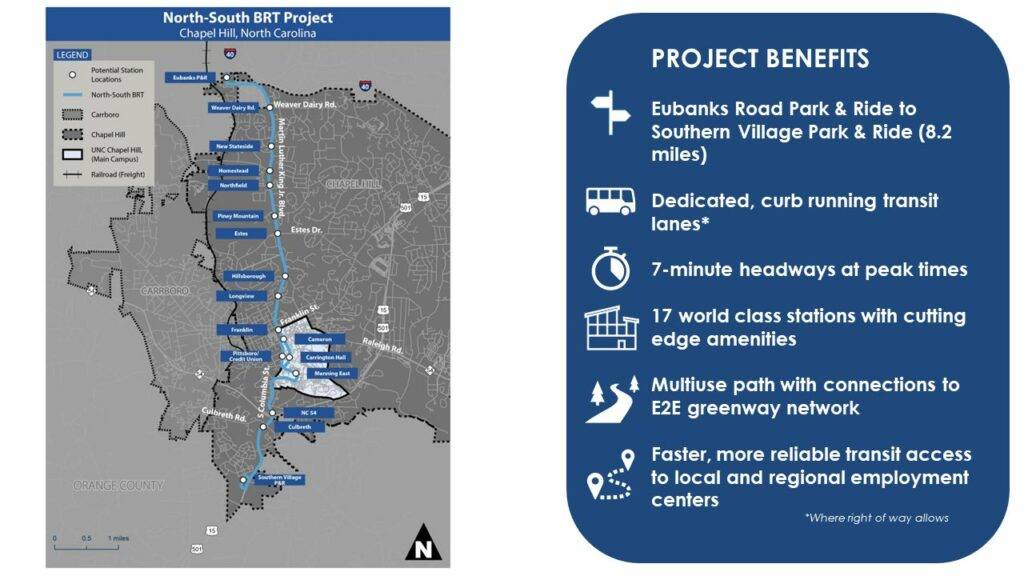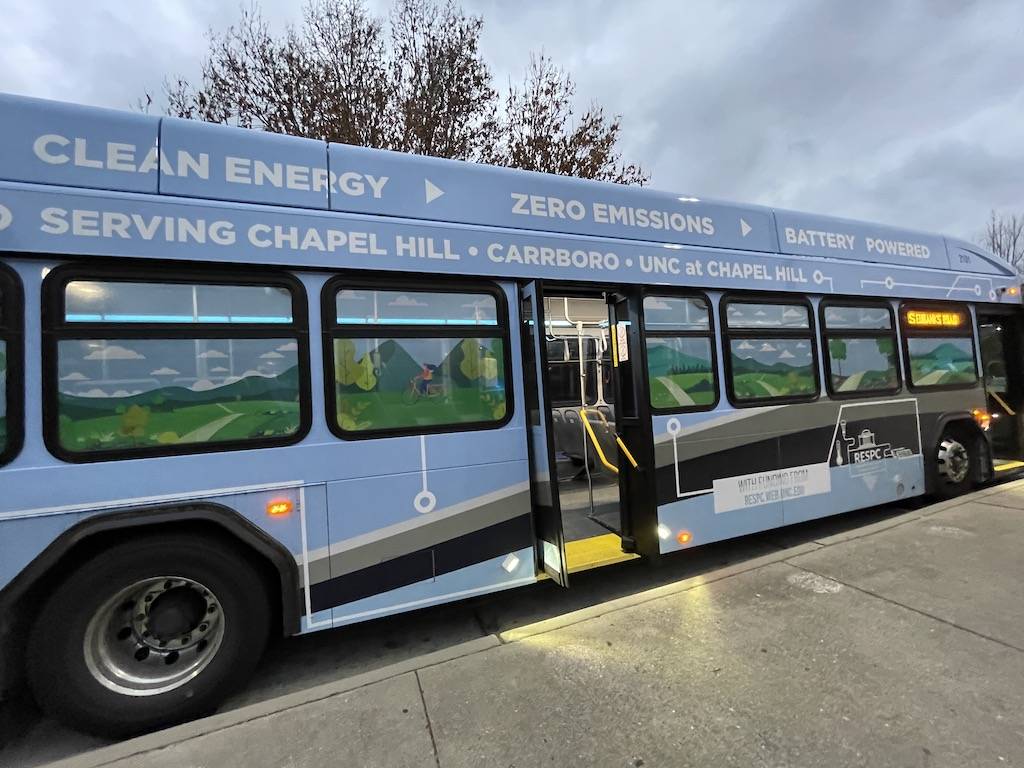This series considers policy questions that will be addressed by the Chapel Hill and Carrboro Town Councils in the next two years. As we always do at Triangle Blog Blog, we will offer our opinions, but we’ll also point you to primary source documents so you can make your own judgment.
What is the North-South Bus Rapid Transit Line (BRT)?
The North-South Bus Rapid Transit line is a years-in-the-making plan to transform Chapel Hill Transit’s busiest bus line, the NS bus that travels down the spine of Chapel Hill along Martin Luther King, Blvd., into a fast, reliable, and frequent transit line that help make our community a stronger and more resilient place. (For more on why BRTs are so cool, see our explainer from last year).
Wait. What is Chapel Hill Transit?
Chapel Hill Transit is Chapel Hill’s fare free bus network. Funded by contributions from the Town of Chapel Hill, the Town of Carrboro, and the University of North Carolina at Chapel Hill, our bus system is the second busiest in the state of North Carolina, trailing only Charlotte in terms of the number of annual riders. It’s kind of a big deal.
Why do we need a BRT line?
As anyone who’s tried to catch a bus near UNC Hospitals at rush hour knows, our bus system is at capacity. It’s not unusual to see multiple buses in a minute, and they struggle to get through traffic to and from campus. We can’t afford to add more road capacity, and our other option, the Durham Orange Light Rail, was killed by the North Carolina State Legislature and Duke University a few years back.
The “rapid” of Bus Rapid Transit comes from giving buses their own lane. The NSBRT will include a dedicated lane for much of the 8.2 mile route, which will cut travel times considerably along the route.
This means if I live along the BRT I will get home faster?
Yes. People who live in Southern Village, work at UNC, live or work downtown, or live anywhere along the corridor within walking distance of MLK, Jr. Boulevard, will be able to use the BRT to get around. In many cases, it will be faster to take the bus than it is to drive, particularly when you account for the time it takes to park, and the buses will be big enough to accommodate bikes on board. And, because the NSBRT connects to two park-and-ride lots (Southern Village and Eubanks), it will also help people who live out of town but want, or need, to spend time in Chapel Hill.

Do the Chapel Hill Town Council candidates support the NSBRT?
For some, the answer is a clear yes. Jess Anderson, Melissa McCullough, Jon Mitchell,Theodore Nollert, and Erik Valera all support the NSBRT.
But what about the others?
Here’s where things get murky. While the NSBRT project is currently being evaluated by the federal government—who will pay for the lion’s share of the construction costs—successful BRTs only work if two things are in play:
- Is the bus running? For this question, we think the answer will almost definitely be yes. Chapel Hill Transit is one of the shining lights of local government. The service is well run. It’s safe. It’s easy to navigate. We fully trust Chapel Hill Transit to run a world-class BRT line.
- Do you live near a bus stop? This is the question that remains unresolved. The next Chapel Hill Town Council will help decide where we will build housing for future generations, including the tens of thousands of students and workers who need to get to UNC’s campus on a regular basis. If we build a great bus line, but don’t build any new housing nearby, it will be of limited value to new residents.
While Adam Searing and his slate of candidates claim to support the NSBRT, many are opposed to transit-oriented development, in part because it means adding more housing—including apartments—in town.
What is transit-oriented development?
Transit-oriented development is exactly what it sounds like, development that is designed to complement existing or future transit lines. We know the opposite phenomenon—highway-oriented development—quite well. Pull off of any interstate exit, and you’ll likely see dozens of businesses oriented around the automobile—gas stations, fast food restaurants with drive-thru windows, and stores with large parking lots. Every business is designed to accommodate cars and, in almost all cases, nothing else.
In transit-oriented development, everything is designed around making it easy to take the bus or train. Instead of drive-throughs, there are sidewalks. Instead of parking lots, there are protected bike lanes. And, most importantly, instead of large single-family homes spaced far apart from one another, there are apartment buildings, townhomes, and diverse housing types for people at all stages of their life.
Does the current Chapel Hill Town Council support transit-oriented development?
In a word, yes. Earlier this year, in an 8-1 vote, the Chapel Hill Town Council supported adding a framework that would allow for transit-oriented development along transit corridors, including Martin Luther King, Jr. Boulevard. Adam Searing voted against this proposal because the non-binding language included a recommendation that the council consider permitting diverse housing types, like duplexes, in neighborhoods along MLK, Jr..
(Essentially, the federal government is more likely to give Chapel Hill $150+ million to build the NSBRT if they think we’re going to build the housing along the corridor that’s necessary to make it succeed. The framework, which was produced over several years and paid for by a federal grant, is effectively a promise to implement transit-oriented development planning.)
Where do the council candidates stand on transit-oriented development?
Mayoral candidate Jess Anderson voted for the proposal as a council member, and supports transit-oriented development as part of the Complete Community framework. Mayoral candidate Adam Searing voted against it, and does not support making the land use changes necessary to make the NSBRT a success.
Likewise, Searing’s slate—Elizabeth Sharp, David Adams, Renuka Soll, Breckany Eckhardt—do not support transit-oriented development. Jeffrey Hoagland is against all redevelopment.
Council member Amy Ryan, who is running for re-election, voted to adopt the transit-oriented development framework. Melissa McCullough, Theodore Nollert, Jon Mitchell, and Erik Valera all support transit-oriented development.
Why does this matter?
Like greenways, council candidates often say they support transit, including the NSBRT. However, if they’re not willing to support the land use changes to make transit successful, the NSBRT will only be a very nice upgrade for people who currently ride the NS bus.

